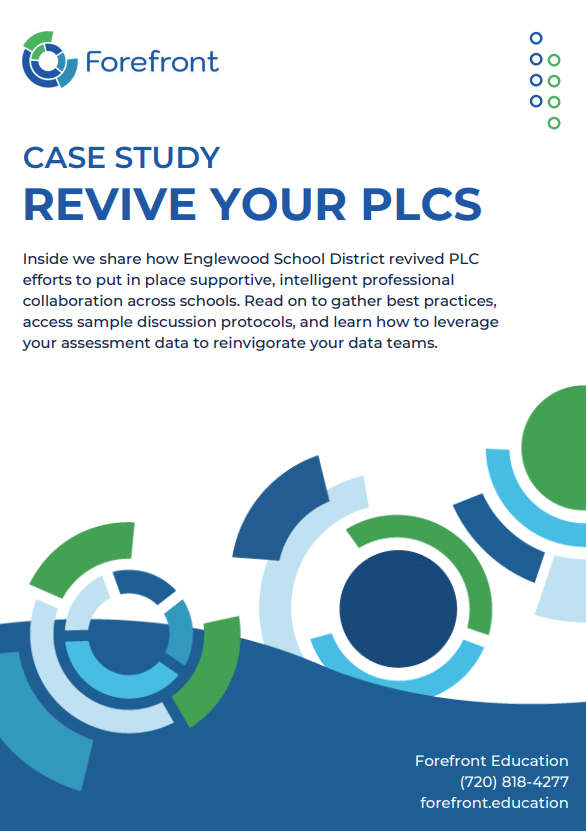Assessment Data: How Much Do You Need?
- October 27, 2023
- Blog
Assessments and assessment data fulfill a wide variety of purposes. From informing instruction to staffing decisions, this valuable information is a school and district’s central intelligence.
If this data is so valuable, then shouldn’t schools be collecting a lot of it? At Forefront Education, we believe that schools need to be intentional about the assessment data that they collect, focusing efforts on gathering more information from fewer data points. That’s because more testing means less instructional time and more time collecting and interpreting data, rather than responding to it. How much is the right amount? Which are the right assessments? As you craft your data strategy, keep in mind these five assessment data needs:
Assessment Data to Understand and Report Student Learning in the Classroom
Classroom assessments are essential for the work teachers do. They are necessary for grading, parent communication, feedback and formative assessment and collaborative work. They are arguably the most important assessments schools use, and are indispensable. When creating an inventory of your assessments, classroom assessment should top the list, but the assessments in this category are voluminous. Classroom assessments range from observations, quick exit tickets, and work samples to unit, module, and cumulative tests. How much data is enough? When thinking about your data collection, consider the purposes of these classroom assessments.
Formative Assessments
There are many assessments that teachers do informally on a daily basis. These observations and daily tasks provide valuable formative information. When deciding how much data from classroom assessments to collect it is always important to first ask, “What is meaningful and manageable?” While formative assessment data is very meaningful, collecting all that information is not manageable. Consider which information can be considered purely formative, such as exit tickets or quick checks for understanding. These ungraded assessments provide powerful resources for feedback without judgment.
Grades and Reporting
Assessment results are necessary for grades and reporting purposes. These data are organized in a grade book system. In their purest form, grades in standards-based grading districts should be the best data points for how students are performing on grade-level expectations. Assessments that are generally included in this are summative tests, projects, and quizzes.
When transitioning to a standards-based grading system, sometimes districts become ambitious in how many grading categories they want to report on to parents. Standards-based grading does not mean you should report on every standard. Standards-based grading experts such as Thomas Guskey recommend limiting standard categories on report cards to fewer than 6 per subject.
Limit standard categories on report cards to fewer than 6 per subject.
How many data points should feed into each of those grading categories? We recommend at least 5-6 tasks aligned to each category. More data points contribute to more accurate grades, but the benefits of this robustness taper off as teachers have to collect 20 or more measures: when the work to collect a robust dataset becomes unmanageable, teacher morale declines.
By grouping learning goals into larger groups with multiple standards, you can ensure that there are adequate data points for each category. This also means that the report cards are short enough that parents and students can understand them more easily. Too many grading categories makes standards-based grading both more difficult to manage and excess specificity makes grades less reliable.
Collaborative Efforts
Classroom assessment results are ideal for the collaborative work that schools do (RtI, MTSS, PLCs, DDI, etc.) These meetings are most efficient and effective when the data used relates directly to immediate learning goals. The level of detail that us desirable lies somewhere between the fine-grained detail of daily formative assessments and overall results from unit assessments.
Because this work is unique to each team of teachers, it is important that they help decide which assessments to use. Meetings should include assessment results that are timely, detailed, and relevant.
Assessment Data to Identify Trends in Student Learning and Identify Learning Gaps
With Forefront, leaders can aggregate classroom assessment data to identify trends in student learning. This allows leaders to organize results by standard or key assessments, such as end-of-year assessment results, to monitor student performance and growth across schools. Leaders can track cohorts of students across academic school years or look at how the district is teaching high-leverage, priority standards year-after-year.
Even with this aggregation, sometimes states and school districts decide that they need additional external measures, such as benchmark or interim assessments, that show performance relative to grade-level standards and peer groups. These assessments help school districts:
-
- Provide a measure of overall student performance and growth across time, independent of other changes that may happen in a district, including curricular adoptions and staffing.
- Identify students who are struggling and in need of additional attention.
- Predict how students may perform on state assessments.
When looking at additional layers of assessment, consider the costs as you do. There are financial costs to purchase these assessments, as well as significant time demands for administering these tests and interpreting results. When examining the assessments of your schools, consider whether there is redundancy in your assessment purposes. Do your classroom assessments serve some of the same purposes that your digital assessments serve? Is this redundancy worth the costs?
Assessment Data for Improvement and Evaluation
When examining your assessment systems, school district leaders have to ask:
-
- Is the data from our assessments providing meaningful information that informs decision-making in our district? Which assessments provide the best information?
- Is the data helpful for informing human and material resource allocation decisions?
- Does our data help leaders to monitor the effectiveness of instructional programs?
- Does it provide meaningful evidence to inform professional learning, collaboration, MTSS, and other systemic efforts?
- Do our measures help to better prepare students in ways that contribute to their overall growth and learning?
To minimize costs, distractions, time demands, and burdens on teachers, we advocate for a “less is more” approach to benchmark and interim assessments. Look for redundancies of purpose, focus on classroom assessments as your core assessments, and consider whether it might be possible to get the information you need with fewer assessments.
Assessment Data to Figure Out Who Needs Help and How to Help Them
Screening assessments are an essential component of your Response to Intervention (RtI) or Multi-Tiered Systems of Support (MTSS) systems. They are often lumped together with benchmark or interim assessments. Interim and benchmark assessments report out student learning on a traditional bell curve. As students are ranked, school and district leaders may use these assessments to identify students in lower percentiles as those needing additional support.
Assessments designed specifically for screening serve a very specific purpose: these short assessments help teachers identify students at risk of not meeting grade-level learning goals. The best screeners also indicate starting places for instruction. Some curricular programs have unit or interim type screeners embedded directly into their programs: these help teachers identify students that will likely struggle with upcoming units if study.
Screeners are preventative, proactive instructional measures. Whether you use a dual purpose benchmark/interim or curriculum-embedded assessments, they provide important data especially at the beginning of the year to help ensure students get the just-in-time supports they need to be successful.
In addition to the tier 1 screening assessments described above, students who receive targeted (tier 2) and intensive (tier 3) assessments should be assessed with more frequent, highly specific assessments in order to monitor progress and ensure that the learning goals of the interventions and special programming are being met.
State Test Data
High-stakes testing is intended to provide school accountability, measuring school and district success at teaching students to the level of proficiency on grade-level learning goals. They provide school and district leaders with another measure that is not necessarily directly aligned to curricular instruction, but that gives insight into student performance and growth.
The limitations of high-stakes testing are when they are used as a diagnostic tool to provide feedback to teachers, and of course, having teacher effectiveness be tied to state test performance made them a particularly explosive and controversial topic. An important data set to consider at the district level, they are not useful for providing meaningful feedback to teachers or parents.
Conclusion
When schools are looking to impact student learning, more assessments will not move the needle. Districts need to work carefully to ensure that assessment systems they have in place help leaders and teachers focus on what is most important, directing resources to high-need areas, and provide meaningful, purposeful information for classroom teachers.
When evaluating a data warehouse solution for assessment data, your district will grapple with this question: What assessment data should we collect and which assessment measures should we ask teachers and administrators to focus on?
As you find answers to this question, which are unique to each district and grounded in your current assessment and grading systems, remember that the data you collect should serve your teachers and administrators with meaningful information that helps them better understand and support student learning. And surprisingly, collecting more data in a way that is not useful or manageable can eat away at precious resources while leading to unintended consequences, such as teacher burnout and frustration.
Contact us today if you are looking to provide your schools with an assessment data solution that helps teachers, and the staff that support them, with meaningful information that can impact student learning.
About Us:
In many data warehouse solutions, gathering data from classroom assessments is an afterthought if not a complete oversight. Forefront, by Forefront Education, is the only assessment data solution that puts classroom assessments at the center of school and district work, leveraging these results to fuel instruction, collaborative work, grading, and decision-making. Elevate meaningful assessment data district-wide to transform how you understand and communicate about student learning across your schools.
About us and this blog
Our team and tools help schools implement standards-based grading, streamline assessment systems, and use meaningful data to drive decision-making.
Free PLC Case Study
Learn about how Forefront client Englewood School District put in place supportive, intelligent professional collaboration across schools. Download your free copy today to access best practices, view sample discussion protocols, and learn how to leverage your assessment data to reinvigorate your data teams.

More from our blog
See all postsForefront is the only assessment data solution optimized for classroom assessment results, leveraging these results to fuel instruction, PLCs, and grading. Elevate meaningful assessment data district-wide to transform how you understand and communicate about student learning across your schools.
Copyright © 2025 Forefront Education, Inc. All Rights Reserved.








